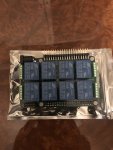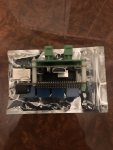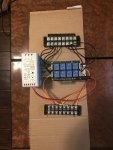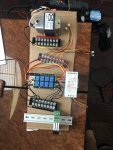- Aug 22, 2017
- 2,592
- Pool Size
- 15000
- Surface
- Plaster
- Chlorine
- Salt Water Generator
- SWG Type
- Hayward Aqua Rite (T-15)
So after reading a bunch of these threads and threatening to do something like this I started to pull the trigger.
Thanks to segalion, jonpcar who have provided very interesting reading, and most of all cmc0619 who ideas I primarily "borrowed"
1 Raspberry Pi 3b
1 Sequentmicrosystems MegaIO relay hat. Plus 1 spare for expansion or when I break this one.
Din rails, plus accessories and a bunch of other stuff I have not ordered yet.
My primary goal for this was to drive 4 valve actuators to go from Pool Mode to Spa Mode. My wife loves the spa and apparently turning 4 valves is too much work (many of you know what I am talking about).
So far I am in the early stages of bench testing this. The Pi is working, the relay hat is working and I can turn the relays off and on via command line and Node Red (thanks again cmc0619).
I will try to document as much of this a possible so that people can copy and improve upon it. However, I got so caught up in the moment tonight I did none of that. Although it is probably a good exercise for me to blow it all away and start over anyway where I can document it.
Things to think about and get comments on about future expansion:
1 Want to measure pH. Seems to be the hardest thing in my pool to keep steady.
2 Set up a Stenner pump to dose acid. (see item 1)
3 Have a single speed pump, should upgrade to a VSP and control that as well (more on this later).
4 Adjust the temperature on my Hayward heater using RS-485 (don't want to cycle the power on and off, just seems kludgy). This item seems the hardest to do, I just cant find the protocol anywhere.
5 Turn my SWG on and off with my pool pump.
Running valve actuators seems pretty simple and is very low risk. If I make a mistake water just goes in the wrong place.
I can do items 3-5 by upgrading my pump to the new Hayward VSP 950 with Omni system for about 2K installed. I can tap one of the relay circuits in the omni to sense spa mode and have my Pi drive the actuators. I figure the pump is worth about $1200 so I am paying about $800 for some automation and the installation which is not a terrible price. BTW for those of you building on top of your Intellicenter configs this would be very similar just with the Hayward version.
Or I can just buy a VSP pump from INYO pools and have my new controller handle everything.
I am happy to answer any questions, and so far this seems like a fairly easy project to do and I am happy to help anyone out.
Thanks to segalion, jonpcar who have provided very interesting reading, and most of all cmc0619 who ideas I primarily "borrowed"
1 Raspberry Pi 3b
1 Sequentmicrosystems MegaIO relay hat. Plus 1 spare for expansion or when I break this one.
Din rails, plus accessories and a bunch of other stuff I have not ordered yet.
My primary goal for this was to drive 4 valve actuators to go from Pool Mode to Spa Mode. My wife loves the spa and apparently turning 4 valves is too much work (many of you know what I am talking about).
So far I am in the early stages of bench testing this. The Pi is working, the relay hat is working and I can turn the relays off and on via command line and Node Red (thanks again cmc0619).
I will try to document as much of this a possible so that people can copy and improve upon it. However, I got so caught up in the moment tonight I did none of that. Although it is probably a good exercise for me to blow it all away and start over anyway where I can document it.
Things to think about and get comments on about future expansion:
1 Want to measure pH. Seems to be the hardest thing in my pool to keep steady.
2 Set up a Stenner pump to dose acid. (see item 1)
3 Have a single speed pump, should upgrade to a VSP and control that as well (more on this later).
4 Adjust the temperature on my Hayward heater using RS-485 (don't want to cycle the power on and off, just seems kludgy). This item seems the hardest to do, I just cant find the protocol anywhere.
5 Turn my SWG on and off with my pool pump.
Running valve actuators seems pretty simple and is very low risk. If I make a mistake water just goes in the wrong place.
I can do items 3-5 by upgrading my pump to the new Hayward VSP 950 with Omni system for about 2K installed. I can tap one of the relay circuits in the omni to sense spa mode and have my Pi drive the actuators. I figure the pump is worth about $1200 so I am paying about $800 for some automation and the installation which is not a terrible price. BTW for those of you building on top of your Intellicenter configs this would be very similar just with the Hayward version.
Or I can just buy a VSP pump from INYO pools and have my new controller handle everything.
I am happy to answer any questions, and so far this seems like a fairly easy project to do and I am happy to help anyone out.





